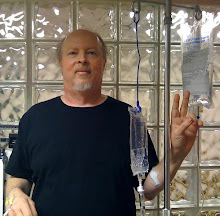Whenever a celebrity of sorts comes down with chronic lymphocytic leukemia there are patients who get a li
 ttle excited, hoping that we have at long last found the poster boy for our cancer (I say “boy” since most of the celebs with CLL seems to be men, at least that we know of.) Michael J. Fox has become associated with Parkinson’s Disease, Lance Armstrong with testicular cancer, and so on. There is a perception among some patients that having a "name" will gain our Rodney Dangerfield leukemia the respect it so richly deserves, after which bucketfulls of money will rain down from the sky, magically translating almost overnight into a cure.
ttle excited, hoping that we have at long last found the poster boy for our cancer (I say “boy” since most of the celebs with CLL seems to be men, at least that we know of.) Michael J. Fox has become associated with Parkinson’s Disease, Lance Armstrong with testicular cancer, and so on. There is a perception among some patients that having a "name" will gain our Rodney Dangerfield leukemia the respect it so richly deserves, after which bucketfulls of money will rain down from the sky, magically translating almost overnight into a cure.Now, if Oprah or Bill Gates or Bono or Bill Clinton were to come down with CLL, we might actually see something like that, or at least the money part. But pending such an A-list victim, I think we have to be a little more realistic here. Having a celebrity speak for us could backfire, especially if the celebrity is old and male, which just confirms the perception that CLL is an old man’s disease that people die with and not because of.
Tom Snyder shunned the role of CLL spokesman. I remember when he announced two years ago on his website, Colortini, that he had CLL (see excerpt at end of this post). There was much excitement on the ACOR CLL list and he was bombarded with helpful tips, suggestions, and not-so-subtle proddings that he could do us all a lot of good if he decided to actively speak about his disease. Snyder said very little as time went on, other than to announce on his website before shutting it down that he had decided to “follow the protocols of Dr. Michael Keating” to treat his CLL. So I presume that he had RFC or the like.
That he managed to die of CLL complications within two years of diagnosis and treatment is unusual, and we should not jump to conclusions about his treatment choice or approach to the disease. But the fact is that a celebrity is no more capable of making the right choices about CLL than you or me; if anything, used to getting “the best” and feeling public pressure to do what is “expected,” they may not be quite as capable of thinking outside the box. (Add to this the fact that many celebrities are not too bright, and many really are as shallow as they appear. I have this on good authority from Marilyn, whose father is a retired Hollywood publicist.)
I believe it is thoughtfulness -- and thinking outside the box -- that we need
 if we are to get closer to a control and cure. Sure, it would be nice to have more money -- especially money that did not come with strings attached from drug companies -- but another area that needs attention is the culture of research. This is true of the cancer community in general.
if we are to get closer to a control and cure. Sure, it would be nice to have more money -- especially money that did not come with strings attached from drug companies -- but another area that needs attention is the culture of research. This is true of the cancer community in general.Here is where I urge you to read Why We’re Losing the War on Cancer by Clifton Leaf, an article that appeared in Fortune a few years ago. (PDF here, if you prefer that to html.)
On the plus side, it is good to hear Leaf say, “The few dramatic increases in cure rates and patient longevity have come in a handful of less common malignancies -- including Hodgkin's, some leukemias . . ."
That's as far as he goes with anything that might be CLL-specific, but the way research is conducted affects us as well as everyone else, and that’s where, Leaf argues, some changes in the “cancer culture” may pay off.
Here's a taste of the article:
“So why aren't we winning this decades-old war on terror -- and what can we do now to turn it around?
“That was the question I asked dozens of researchers, physicians, and epidemiologists at leading cancer hospitals around the country; pharmacologists, biologists, and geneticists at drug companies and research centers; officials at the FDA, NCI, and NIH; fundraisers, activists, and patients. During three months of interviews in Houston, Boston, New York, San Francisco, Washington, D.C., and other cancer hubs, I met many of the smartest and most deeply committed people I've ever known. The great majority, it should be said, were optimistic about the progress we're making, believing that the grim statistics belie the wealth of knowledge we've gained -- knowledge, they say, that will someday lead to viable treatments for the 100-plus diseases we group as cancer. Most felt, despite their often profound misgivings about the way research is done, that we're on the right path.
“Yet virtually all these experts offered testimony that, when taken together, describes a dysfunctional "cancer culture" -- a groupthink that pushes tens of thousands of physicians and scientists toward the goal of finding the tiniest improvements in treatment rather than genuine breakthroughs; that fosters isolated (and redundant) problem solving instead of cooperation; and rewards academic achievement and publication over all else.
“At each step along the way from basic science to patient bedside, investigators rely on models that are consistently lousy at predicting success -- to the point where hundreds of cancer drugs are thrust into the pipeline, and many are approved by the FDA, even though their proven "activity" has little to do with curing cancer."
In other words, we need to be thinking outside the box, making jumps and connections that might achieve genuine breakthroughs. Wars are won not only by slow and incremental attack; sometimes fortune favors the bold.
I wish we could send Dr. Keating and the other top dozen CLL experts in the world on a retreat and tell them, “Take your time, Money is no object. Forget your egos. Talk about the offbeat ideas you have been husbanding in the back of your mind, share your wish lists, sit around and drink too much Scotch and shoot the bull.”
And I would stick s
 ome creative thinkers from other disciplines in the room with them -- Steve Jobs-types, and our own Chaya Venkat -- to challenge their notions and light fires in their imaginations.
ome creative thinkers from other disciplines in the room with them -- Steve Jobs-types, and our own Chaya Venkat -- to challenge their notions and light fires in their imaginations.And then let’s set up a little private research center where the experts and the thinkers can come and work anonymously, creatively, crazily.
Would something come of it? We’ll never know until I win Powerball or Oprah starts noticing lumps in her neck.
EXCERPTS FROM TOM SNYDER'S BLOG
Below is an excerpt from Tom Snyder's blog discussing the discovery of his leukemia. I always liked Tom; he was pixilated, which the dictionary defines as "behaving as if mentally unbalanced; very eccentric. Whimsical; prankish. Slang Intoxicated; drunk." Here's to you, Tom; I hope they serve good martinis up there, and don't talk the Big Guy's ear off.
A cat scan turned up some interesting stuff. My spleen is enlarged, which the doctors say might be crowding my stomach in my abdomen, thereby causing some of the bloating I am experiencing. And judging by my white cell count and a variety of other factors including what was shown on the cat scan, I have been diagnosed with something called chronic lymphocytic leukemia. Jesus H. Christ! When I was a kid leukemia was a death sentence. Now, my doctors say its treatable! With pills or chemotherapy or a combination of both. Lemme pause here on this word treatable.Four years ago they stuck a defibrillator/pacemaker in my chest because my heart disease was treatable! A year and a half ago a nearly torn tendon in my left leg was diagnosed as treatable. Then I came down with atrial fibrillation, but was told not to worry about that because it is treatable! I don't know how much more room I have in my aging carcass for this treatable shit! Anyway, my doctors assure me this is nothing to worry about, and I have to accept that, I guess. They say this kind of leukemia is not fatal, that people can live with it for thirty years. Notice, they don't say people will live thirty years. But they "can" live up to thirty years. Considering I will be sixty nine years old next month I ain't looking for thirty years, but fifteen more would be nice! I looked up chronic lymphocytic leukemia on the Internet and found a source that predicted people who are diagnosed early can live up to twelve years. Those who are not diagnosed early--and the website does not define "early"-- have a survival rate of about two years. I don't know if my diagnosis was early or late.My doctors say this disease (which I'll refer to as CLL from now on) has a very slow rate of progression. I had more blood work done today to make certain this diagnosis is correct. The doctors will have the results of this in a week or so and then we will see what treatment they recommend. I am going to Northern California for about two weeks and I am not taking my leukemia with me. The doctors say that's okay with them.











